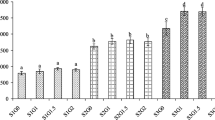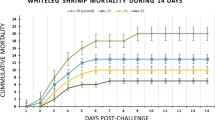Abstract
The dominant microalgal species, quantity of heterotrophic bacteria and Vibrio in the intestines and gills of Litopenaeus vannamei (Pacific white shrimp), positive detection rate of white spot syndrome virus (WSSV), and water quality indices were investigated at the final culture stage (88th day in culture season). Correlation of microalgal community, bacteria quantity, and shrimp production were analyzed by statistical analysis methods. Every 10 days, probiotics were used in groups A, B, and C, consisting of Bacillus, photosynthetic bacteria (PSB), and equal parts Bacillus and PSB, respectively. The results showed that production (25597.33 ± 928.46 kg ha−1) and survival rate (77.06 ± 9.00 %) was the highest in group C, but positive detection rate of WSSV was the lowest. The microalgal community of group C was significantly dominated by Chlorella pyrenoidosa, with an average density and dominance of (289.52 ± 142.10) × 107 cells L−1 and 0.878 ± 0.161, respectively. The correlation analysis indicated a significant negative correlation between Cyanophyta dominance and shrimp production (P < 0.05), while the relationship between production and Vibrio quantity was not significantly correlated (P > 0.05). Accordingly, microalgal dominant species should be controlled as a key factor in the shrimp culture season; in particular, the dominance of Cyanophyta should be restricted to a low level. Meanwhile, the combined use of Bacillus and PSB probiotics was considered an effective solution to optimize microalgal communities and controlling the cell density of Cyanophyta.


Similar content being viewed by others
References
Alonso-Rodriguez R, Paez-Osuna F (2003) Nutrients, phytoplankton and harmful algal blooms in shrimp ponds: a review with special reference to the situation in the Gulf of California. Aquaculture 219:317–336
APHA (American Public Health Association) (1998) Standard methods for the examination of water and waste water, 20th edn. American Public Health Association, Washington DC
AQSIQ (General Administration of Quality Supervision, Inspection and Quarantine of the People’s Republic of China) (2008) The specification for marine monitoring—Part 4. Seawater analysis and Part 7. Ecological survey for offshore pollution and biological monitoring. Standards Press of China, Beijing
BFMA (Bureau of Fisheries, Ministry of Agriculture of the People’s Republic of China) (2011) Chinese Fisheries Yearbook 2011. China Agriculture Press, Beijing
Bolinches J, Romalde JL, Toranzo AE (1988) Evaluation of selective media for isolation and enumeration of Vibrios from estuarine waters. J Microbiol Meth 8:151–160
Boyd CE (1989) Water quality management and aeration in shrimp farming. Fisheries and Allied Aquaculture Department Series No. 2 Alabama Agriculture Experiment Station. Auburn University, Alabama
Boyd CE, Jason WC (1998) Shrimp aquaculture and the environment. Sci Am 7:58–65
Burford M (1997) Phytoplankton dynamics in shrimp ponds. Aquacult Res 28:351–360
Cain ML, Bowman WD, Hacker SD (2011) Ecology (second edition). Sinauer Associates, Inc., Sunderland
Carmichael WW (1992) Cyanobacteria secondary metabolites the cyanotoxins. J Appl Bacteriol 72:445–459
Chanratchakool P, Pearson M, Limsuwan C, Roberts RJ (1995) Oxytetracycline sensitivity of Vibrio species isolated from diseased black tiger shrimp, Penaeus monodon Fabricius. J Fish Dis 18:79–82
Chien YH (1992) Marine shrimp pond management: a review. In: Wyban J (ed) Proceeding of the special session on shrimp farming. World Aquaculture Society, Baton Rouge, pp 30–42
Crab R, Defoirdt T, Bossier P, Verstraete W (2012) Biofloc technology in aquaculture: beneficial effects and future challenges. Aquaculture 356–357:351–356
Cremen MCM, Martinez RMG, Corre VLJ, Azanza RV (2007) Phytoplankton bloom in commercial shrimp ponds using green-water technology. J Appl Phycol 19:615–624
Fernades SO, Kulkarni SS, Shirodkar RR, Karekar SV, Kumar RP, Sreepada RA, Vogelsang C, Loka Bharathi PA (2010) Water quality and bacteriology in an aquaculture facility equipped with a new aeration system. Environ Monit Assess 164:81–92
Gatesoupe FJ (1999) The use of probiotics in aquaculture. Aquaculture 160:177–203
Ge F (2005) The Modern Ecology. Chinese Science Press, Beijing
Guan YQ (2003) Effects of some typical environmental factors on the immune responses and outbreaks of white spot syndrome in penaeid shrimp. Graduate University of Chinese Academy of Sciences
Guo H, Yu ZG (1996) The characteristics of phytoplankton community in prawn pond and the relationships with shrimp disease. Mar Sci 1:39–45 (in Chinese with English abstract)
Janeoa RL, Corre VLJ, Sakatab T (2009) Water quality and phytoplankton stability in response to application frequency of bioaugmentation agent in shrimp ponds. Aquacult Eng 40:120–125
Komárková J, Komárek O, Hejzlar J (2003) Evaluation of the long term monitoring of phytoplankton assemblages in a canyon-shape reservoir using multivariate statistical methods. Hydrobiologia 504:143–157
Lavilla-Pitogo CR, Baticados MCL, Cruz-Lacierda ER, Pena LD (1990) Occurrence of luminous bacterial diseases of Penaeus monodon larvae in the Philippines. Aquaculture 91:1–13
Li SH, Li ZJ, Yang YY, Cao YC, Hu XJ, Yang YF (2009) The dynamic study of bacteria from autumn to winter in the Litopenaeus vannamei cultured ponds. J Jinan Univ (Nat Sci Med Ed) 30:343–348
Lo CF, Leu JH, Hol CH, Chen CH, Peng SE, Chen YT, Chou CM, Yeh PY, Huang CJ, Chou HY, Wang CH, Kou GH (1996) Detection of baculovirus associated with white spot syndrome (WSBV) in penaeid shrimps using polymerase chain reaction. Dis Aquat Organ 25:133–141
Ma KP, Liu YM (1994) Measurement of biotic community diversity I: methods for estimating the alpha diversity (α-diversity). Chin Biodivers 2:231–239
Mackenzie A, Ball AS, Virdee SR (2007) Instant notes in ecology. Chinese Science Press, Beijing
Martinez MP, Chakroff JB, Pantastica JB (1975) Direct phytoplankton counting technique using the hemocytometer. Philipp Agric 59:43–50
Muller-Feuga A (2000) The role of microalgae in aquaculture: situation and trends. J Appl Phycol 12:527–534
Neori A (2011) “Green water” microalgae: the leading sector in world aquaculture. J Appl Phycol 23:143–149
Niedzwiadek B, Scott PM, Lau BP (2012) Monitoring of shrimp and farmed fish sold in Canada for cyanobacterial toxins. J Food Prot 75:160–163
Parsons TR, Malta Y, Lalli CM (1984) A manual of chemical and biological methods for seawater analysis. Pergamon Press, Oxford
Prayitno SB, Latchford JW (1995) Experimental infections of crustaceans with luminous bacteria related to Photobacterium and Vibrio. Effect of salinity and pH on infectiosity. Aquaculture 132:105–112
Primavera JH (1993) A critical review of shrimp pond culture in the Philippines. Rev Fish Sci 1:151–201
SEPAC (State Environmental Protection Administration of China) (2006) A manual of monitoring and analysis methods for water and waste water. China Environmental Science Press, Beijing
Smee DL (2012) Species with a large impact on community structure. Nat Educ Knowl 3/10:40
Tookwinas S, Songsangjinda P (1999) Water quality and phytoplankton communities in intensive shrimp culture ponds in Kung Krabaen Bay, eastern Thailand. J World Aquacult Soc 30:36–45
Troell M, Ronnback P, Halling C, Kautsky N, Buschmann A (1999) Ecological engineering in aquaculture: use of seaweeds for removing nutrients from intensive mariculture. J Appl Phycol 11:89–97
Wang YB, Xu ZR, Xia MS (2005) The effectiveness of commercial probiotics in northern white shrimp Penaeus vannamei ponds. Fish Sci 71:1036–1041
Wang YL, Li ZJ, Zhang JS, Wen GL, Cao YC, Luo L, Zhang HJ, Han N (2012) Study on the variation of WSSV in Litopenaeus vannamei during the cultured periods in ponds above sea level. J Fish Sci China 19:301–309 (in Chinese with English abstract)
Xie ST, He JG, Yang XM, Lu L, Jiang JB (2001) Detection of white spot syndrome virus (WSSV) in Penaeus Monodon using nested PCR. J Ocean Univ China 31:220–224
Xu B, Xu HS, Ji WS, Shi J (1994) Pathogens and pathogenicity to Penaeus orientalis Kishinouye. Acta Oceanol Sin 13:297–304
Yusoff FM, Zubaidah MS, Matias HB, Kwan TS (2002) Phytoplankton succession in intensive marine shrimp culture ponds treated with a commercial bacterial product. Aquacult Res 33:269–278
Zhang L (2006) The application of SPSS in the biological statistics. Xiamen University Press, Xiamen, pp. 129–133
Acknowledgments
This research was supported by the program of China agriculture research system (CARS-47), special fund for agro-scientific research in the public interest (201103034), science and technology planning project of Guangdong province (2012B020308003), projects of agricultural science and technology achievements transformation (2012GB23260551), and special scientific research funds for central non-profit institutes, South China Sea Fisheries Research Institute, Chinese Academy of Fishery Sciences (2013ZD02).
Author information
Authors and Affiliations
Corresponding author
Rights and permissions
About this article
Cite this article
Cao, Yc., Wen, Gl., Li, Zj. et al. Effects of dominant microalgae species and bacterial quantity on shrimp production in the final culture season. J Appl Phycol 26, 1749–1757 (2014). https://doi.org/10.1007/s10811-013-0195-0
Received:
Revised:
Accepted:
Published:
Issue Date:
DOI: https://doi.org/10.1007/s10811-013-0195-0




